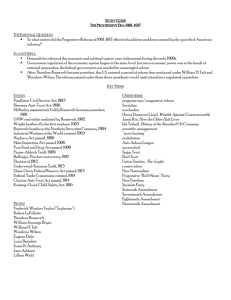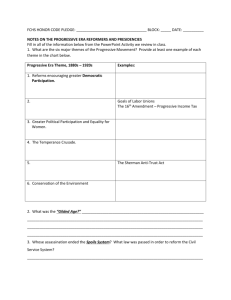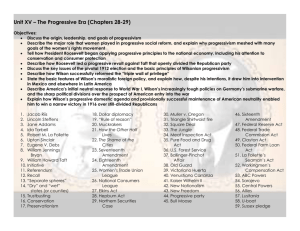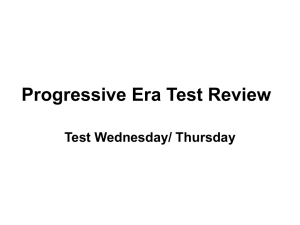progressive test
advertisement
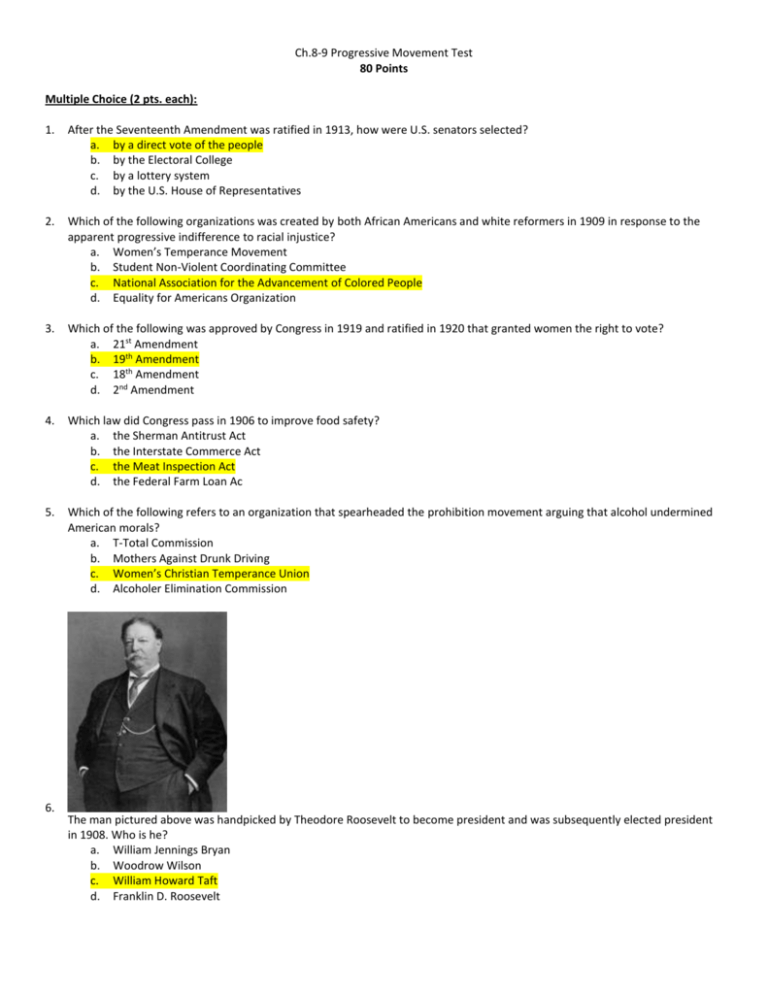
Ch.8-9 Progressive Movement Test 80 Points Multiple Choice (2 pts. each): 1. After the Seventeenth Amendment was ratified in 1913, how were U.S. senators selected? a. by a direct vote of the people b. by the Electoral College c. by a lottery system d. by the U.S. House of Representatives 2. Which of the following organizations was created by both African Americans and white reformers in 1909 in response to the apparent progressive indifference to racial injustice? a. Women’s Temperance Movement b. Student Non-Violent Coordinating Committee c. National Association for the Advancement of Colored People d. Equality for Americans Organization 3. Which of the following was approved by Congress in 1919 and ratified in 1920 that granted women the right to vote? a. 21st Amendment b. 19th Amendment c. 18th Amendment d. 2nd Amendment 4. Which law did Congress pass in 1906 to improve food safety? a. the Sherman Antitrust Act b. the Interstate Commerce Act c. the Meat Inspection Act d. the Federal Farm Loan Ac 5. Which of the following refers to an organization that spearheaded the prohibition movement arguing that alcohol undermined American morals? a. T-Total Commission b. Mothers Against Drunk Driving c. Women’s Christian Temperance Union d. Alcoholer Elimination Commission 6. The man pictured above was handpicked by Theodore Roosevelt to become president and was subsequently elected president in 1908. Who is he? a. William Jennings Bryan b. Woodrow Wilson c. William Howard Taft d. Franklin D. Roosevelt 7. Which law did Congress pass in 1906 to require that food and drugs be labeled correctly? a. the Pure Food and Drug Act b. the Sherman Antitrust Act c. the Interstate Commerce Act d. the Pendleton Act 8. President Theodore Roosevelt was very interested in the conservation movement that had evolved during the late 1800s. Which of the following best describes Roosevelt's role in the conservation movement? a. He promoted recycling programs and encouraged people to consume less. b. He became interested in renewable sources of energy and worked to increase energy efficiency. c. He created new laws to reduce the amount of pollution emitted from factories. d. He expanded the national park system and supported government policies that managed natural resources 9. The Interstate Commerce Act of 1887 authorized the federal government to regulate the railroad industry. Which group of people was most supportive of government regulation of the railroad industry? a. farmers b. railroad owners c. miners d. teachers 10. What did the 16th Amendment accomplish? a. It provided for the popular election of Senators. b. It established an income tax. c. It prohibited the sale of alcohol. d. It granted suffrage to women 11. Which practice does the photo above show that Progressive leaders were trying to regulate? a. indentured servitude b. union organization c. child labor d. assembly lines 12. Which term best describes journalists who worked to expose abuses of corporate power, thereby gathering public support for regulation and reform, during the Progressive Era? a. suffragists b. muckrakers c. unionizers d. trustbusters 13. Which of the following placed a nation-wide ban on the production, distribution, and sale of alcoholic beverages in the U.S.? a. 19th Amendment b. 21st Amendment c. 18th Amendment d. 14th Amendment 14. The Progressive Movement was characterized by a. politically active farmers who were united by a platform to abandon the gold standard for currency. b. efforts to better American society through reform, expanded democracy, science, and government regulation. c. constant civil disobedience on the part of activists determined to secure equality for African Americans. d. the belief that the United States should involve itself more actively in foreign affairs and become expansionist. 15. Which of the following terms describes the process by which citizens can introduce legislation by signing a petition? a. primary election b. recall c. initiative d. referendum 16. Which of the following best completes the diagram? a. Reasons for the Founding of the NAACP b. Progressive Era Voting Reforms c. Goals of Women's Suffragists d. Ways in which Government Corruption Occurred 17. Woodrow Wilson served as President from 1913-1921 and was instrumental during the Progressive Movement during his first term. However, what was Wilson burdened with during his second term that brought an end to the Progressive Movement? a. Great Depression b. World War I c. Japanese attack on Pearl Harbor d. Spanish-American War 18. Which of the following organizations were created to protect social welfare during the Progressive Movement? a. YMCA b. Prohibition Society c. Salvation Army d. Both A & C 19. In a referendum, citizens get to vote a. on whom they want to represent them in the legislature. b. to approve or reject a law that has been proposed in the legislature. c. to remove elected officials from office who they feel have been doing a bad job. d. on whom they want to serve as the president of the United States. United States Constitution Amendment XIX The right of citizens of the United States to vote shall not be denied or abridged by the United States or by any State on account of sex. 20. Though not alive when this amendment was passed, who of the following had the greatest impact on its creation? Congress shall have power to enforce this article by a. Eugene Debs appropriate legislation. b. Susan B. Anthony c. W.E.B. DuBois d. Shirley Chisholm 21. Which of the following institutions was one of President Wilson’s greatest achievements and is still the basis of the nation’s banking system? a. Department of the Treasury b. Federal Reserve System c. Federal Trade Commission d. Income Tax System 22. The Progressive Party, or the “Bull Moose Party” was formed in 1912 in response to which president’s desire to seek a third term in office? a. Franklin Roosevelt b. Abraham Lincoln c. Ronald Reagan d. Theodore Roosevelt 23. Which of the following pieces of legislation attacked child labor by prohibiting transportation of child made goods across state lines? a. Child Labor Act b. Keating-Owen Act c. Crusade for Children Act d. Knights of Labor Act 24. • relief for farm workers • lowering of income taxes • public control of resources •? The chart above lists issues that Robert La Follette supported. Which of the following would best complete the chart? a. strengthening of the government b. reform of the judicial system c. ending of corporate monopolies d. increase in international trade 25. To which idea did Susan B. Anthony devote her life's work? a. gaining suffrage for women b. helping the urban poor c. achieving equal pay for women d. the Civil Rights movement 26. As President, Theodore Roosevelt used his power to influence news media, shape legislation, and protect common people from big businesses. The reforms made by Roosevelt during the Progressive Movement is referred to as a. The New Deal b. Progressive Deal c. Square Deal d. Little Man’s Deal 27. Which of the following pieces of legislation was created as a compromise between the House and the Senate that dealt with tariff rates in the U.S.? a. Taft Tariff Act b. Payne-Aldrich Act c. National Trade Act d. Interstate Trade Act of 1908 28. Which of the following events involved 140,000 coal miners striking in Pennsylvania after demanding better pay, working hours, and ability to create a workers union and eventually resolved the situation after intervention by the federal government? a. 1902 Coal Strike b. Homestead Miner’s Strike c. Great Strike of 1914 d. Triangle Shirtwaist Protest 29. What was the impact of muckraker journalist Ida Tarbell's History of the Standard Oil Company? a. It led to the breakup of the company as a monopoly. b. It led to the passage of the Sherman Anti-Trust Act. c. It led to the passage of the Pure Food and Drug Act. d. It led to better working conditions for women and children 30. Upton Sinclair's novel The Jungle was intended as a criticism of the capitalist system; it a. led to improved working conditions for women and children. b. led to greater oversight of the meatpacking industry. c. led to improved living conditions for the working class. d. helped to rid the United States of "wage slavery." 31. During Woodrow Wilson's term as governor of New Jersey, he implemented many progressive reforms such as a workmen's compensation law, a commission that regulated transportation and public utilities, and electoral reform. Wilson's accomplishments as governor helped him to a. be nominated to serve on the U.S. Supreme Court. b. become the CEO of a large corporation. c. become a U.S. Senator representing New Jersey. d. be elected president in the 1912 election. 32. The picture above defends Roosevelt’s reputation as a President who attacked huge corporations (ex: Standard Oil) for creating trusts and monopolies. Which of the following is the best term for describing Roosevelt’s stance on big business? a. Trustbuster b. Rough Rider c. Trust Cowboy d. Big Stick Diplomacy 33. Which of the following commissions was established by Woodrow Wilson that investigated unfair business practices by obtaining periodic reports from large corporations? a. Federal Bureau of Investigation (FBI) b. Central Intelligence Agency (CIA) c. Department of Homeland Security (DHS) d. Federal Trade Commission (FTC) 34. The man pictured above was among the first prominent African Americans to advocate for equality and was influential in the creation of the NAACP. Who is he? a. Booker T. Washington b. Martin Luther King Jr. c. W.E.B. Du Bois d. Malcolm X 35. Which of the following was a goal during the progressive movement? a. Protecting Social Welfare b. Promoting Moral Improvement c. Creating economic reform d. All of the above True/False (2 pts. Each): 36. Prior to workplace reforms for women, they were paid 50% less than males. a. True b. False 37. Theodore Roosevelt was the first Vice President to become President after the assassination of William McKinley . a. True b. False 38. The Prohibition Movement and the 18th Amendment had the opposite effect on American society as anticipated by those who supported both. a. True b. False 39. Under the Federal Reserve System, the country is divided into 12 banking districts. a. True b. False 40. Both Theodore Roosevelt and Woodrow Wilson dismissed the Civil Rights issue in the U.S. during their terms as president. a. True b. False
